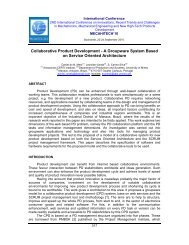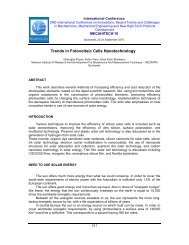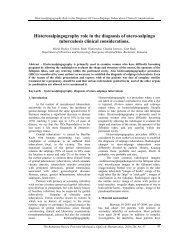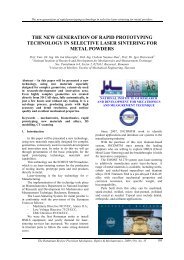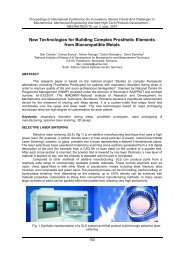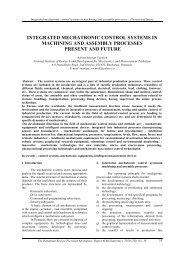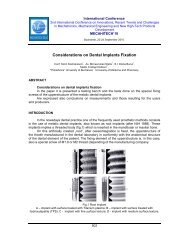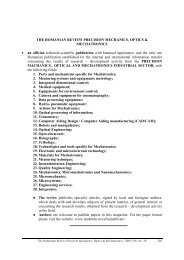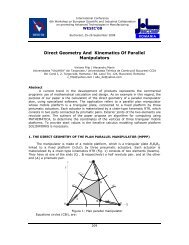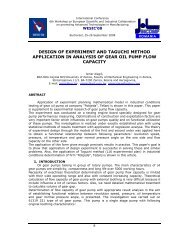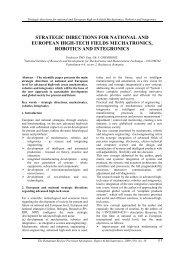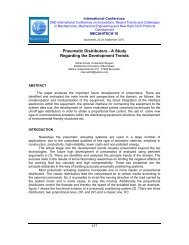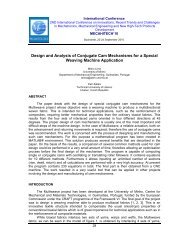PAPER TITLE - incdmtm
PAPER TITLE - incdmtm
PAPER TITLE - incdmtm
You also want an ePaper? Increase the reach of your titles
YUMPU automatically turns print PDFs into web optimized ePapers that Google loves.
International Conference<br />
1ST International Conference on Innovations, Recent Trends and Challenges<br />
in Mechatronics, Mechanical Engineering and New High-Tech Products<br />
Development<br />
MECAHITECH‘09<br />
Bucharest, 8-9 October 2009<br />
The Implementation of the Hamming Codes for Sending Information<br />
Ing. Cristian Sirbu, Ing. Adrian Tanase, Ing. Codrut Darie, Ing. Adrian Vladasel<br />
National Institute of Research and Development for Mechatronics and Measurement Technique<br />
6-8 Pantelimon Road, 2nd District, 021631, Bucharest, Romania<br />
E-mail: cefin@cefin.ro; <strong>incdmtm</strong>@<strong>incdmtm</strong>.ro<br />
Sending data is considered by everybody the main link in what we may usually call<br />
information technology. More correctly we may say it is about the information science. The<br />
apparent dichotomy from this combination of words “information and data transmission”<br />
suggests in fact the theoretical substantiation: the information theory from which<br />
derives/results the main application: data transmission (at distance).<br />
For the moment we shall consider that data transmission means only one sense of<br />
the information transfer from a source to the user, while the communication means the<br />
information transfer between two equipments (terminals) both ways. Thus, because usually<br />
the transfer channel is used bidirectional, we are going to call it from now on channel of<br />
communication and we’ll use for the ensemble providing the change of information the name<br />
of system of communication.<br />
The technological progresses: transducers, integrated circuits, microprocessors,<br />
laser, satellites of communication made possible that the developed communication systems<br />
to allow the transmission wherever in the world of any kind of information: voice, text,<br />
drawings, images, etc.<br />
In the mean time, the present industrial époque means the improvement of the<br />
industrial processes automation and possibilities to control them by the computer. This<br />
development showed the necessity of communication between different intelligent<br />
equipments and the calculation/counting system and also between equipments (machines)<br />
and the human operator.<br />
The kind of the sent information has developed so that symbols are used in the<br />
discrete technique thus it has been replaced the analogical measurement technique of<br />
sending information.<br />
33
International Conference<br />
1ST International Conference on Innovations, Recent Trends and Challenges<br />
in Mechatronics, Mechanical Engineering and New High-Tech Products<br />
Development<br />
MECAHITECH‘09<br />
Bucharest, 8-9 October 2009<br />
The Implementation of the Hamming Codes Using the Matlab Program<br />
Matlab is a very high level language presenting important performances from the<br />
point of view of the technical calculation (Matlab represents a shortcut of the words “Matrix<br />
Laboratory”). Beside the control interpreter are presented tools such as those for visualizing<br />
data, sounds and images, electrical circuits analyze,<br />
etc.<br />
Notions/Details about Simulink Library. Simulink is a package of programs for<br />
modeling, simulation and analyze dynamic systems. It may be simulated linear and non<br />
linear systems during ongoing shaping , discrete or in a combination of the two. The systems<br />
may have parts with different sampling frequencies.<br />
Hamming Codes<br />
Hamming Codes represent a special category of the block codes correcting errors.<br />
These codes and their derived variants are largely used for correcting errors in digital<br />
communications and in data storage systems.<br />
For any positive whole m ≥ 3 exists a Hamming code having the following<br />
parameters:<br />
- length of the code n = 2 m -1;<br />
- number of the information symbols: k = 2 m – m - 1 ;<br />
- number of the control symbols: n - k = m;<br />
- correction capacity: t = 1(d min =3)<br />
Applications Hamming codes. Hamming codes are a part of block codes. These<br />
codes are perfect codes, correcting errors, correcting all the simple errors structures but no<br />
combination of double errors, detecting all the error structure one or two errors.<br />
In order to show the utility of the Hamming code we use the following model/design:<br />
Random<br />
Integer<br />
Random Integer<br />
Generator<br />
Integer to Bit<br />
Converter<br />
Integer to Bit<br />
Converter<br />
Hamming Encoder<br />
Hamming Encoder<br />
BSC<br />
Err<br />
Binary Symmetric<br />
Channel<br />
Hamming Decoder<br />
Hamming Decoder<br />
1<br />
Bit to Integer<br />
Converter<br />
Bit to Integer<br />
Converter<br />
Tx<br />
Error Rate<br />
Calculation<br />
Rx<br />
Error Rate<br />
Calculation<br />
13<br />
numarul generat<br />
1<br />
1<br />
0<br />
1<br />
secventa de informatie<br />
0<br />
0<br />
0<br />
1<br />
1<br />
0<br />
0<br />
0<br />
1<br />
1<br />
0<br />
1<br />
1<br />
1<br />
0<br />
1<br />
secventa estimata<br />
13<br />
numarul receptionat<br />
1<br />
secventa receptionata<br />
cuvantul codat<br />
Matrix<br />
Sum<br />
numarul erorilor<br />
introduse<br />
1<br />
0<br />
0<br />
0<br />
0<br />
0<br />
0<br />
34<br />
eroarea introdusa<br />
Scheme made in Simulink for Hamming code
International Conference<br />
1ST International Conference on Innovations, Recent Trends and Challenges<br />
in Mechatronics, Mechanical Engineering and New High-Tech Products<br />
Development<br />
MECAHITECH‘09<br />
Bucharest, 8-9 October 2009<br />
We are using the following blocks:<br />
Random-Integer Generator: generating integers numbers distributed in the interval<br />
(0,M-)<br />
The parameters of the block are:<br />
- “M-ary number” is 2^4 because the Hamming used code is C(7,4) and numbers<br />
generated are binary represented on 4 bit,<br />
- “Initial seed” is 12345. Modifying this parameter is modified the generated number<br />
sequence.<br />
- “Sample time” is 1. Generates one number each second.<br />
Integer to Bit Converter: transforms a vector of integers in a vector of bit.<br />
The block parameter is:<br />
- “Number of bit per integer” is 4<br />
Hamming Encoder: creates a Hamming code from the binary vector.<br />
The block parameter are:<br />
- “Codeword length N” is 7.<br />
- “Message length” is 4 because is used the code C(7,4).<br />
Binary Symmetric Channel: introduces binary errors.<br />
The parameters of the block are:<br />
- “Error probability” is 0.29 for introducing one error.<br />
- Input vector length” is 7 because the code word added is represented on 7 bit.<br />
- “Initial seed” is 1234.<br />
- “Sample time” is 1 to generate a sample at each second.<br />
Hamming Decoder: decoders a Hamming code to restore the sent binary vector.<br />
The block parameters are:<br />
- “Codeword length K” is 7.<br />
- “Message length K” is 4 because the used code is C(7,4).<br />
The implementation of the Hamming codes and its derived variants contributes/allow the<br />
error corrections in digital communication and in the data storage systems.<br />
35



